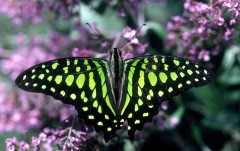ALA Article from Australian Geographic site. Accessed 10 June 2011.
Just one click to identify Australian species
By Natalie Muller (edit ALA)
Australian wildlife enthusiasts are putting our native species on the map, all with the click of a mouse.
DONALD HOBERN REMEMBERS spending much of his childhood looking at beetles and moths without knowing how to identify what he was looking at. What he needed was a good book – one with pictures, descriptions and species distribution maps.
Now a trained computer programmer, Donald is using his information technology skills to further his interest in natural history. He is leading a project that aims to make Australian biology collections available to the public via the web. Donald is the inaugural director of the Atlas of Living Australia, an online treasure trove of data about Australia’s native plants and animals. “The biggest problem most people have in understanding the wildlife around them is not knowing how to identify them,” he says.

The interactive encyclopaedia, which acts as both a Yellow Pages of Australian species and a social networking site for naturalists, is still a work in progress. But Donald hopes it will be a handy resource for experts and policy makers, as well as for kids, eco-tourists, educators, NRM managers and amateur naturalists.
So far the Atlas features downloadable distribution charts, identification tools, images, scientific literature and data sets that provide as complete a picture as possible about each species. Eventually, DNA barcoding data will also be added.
The Atlas was launched late last year and already contains more than 23 million records from museums and data collections around the country. But digitising Australia’s wildlife records is no small task.
That’s one of the reasons why the Atlas team is encouraging the public to upload their own field notes, sightings and photographs to the encyclopaedia’s citizen science portal.
Citizen science
For many years, dedicated community groups have played an important role in collecting field data in the name of science. By throwing online tools into the mix, data sharing between experts and enthusiastic volunteers has been revolutionised. ClimateWatch, Birds Australia, RabbitScan, Birdata, and FungiMap are just some examples of networks that are now using online applications to share their information via the Atlas’s portal.
Dr John Hooper, Head of the Biodiversity and Geosciences programs at the Queensland Museum, says the Atlas is a real benchmark for science.
“People these days are impatient, they’d much rather go to the web, so this offers them the option to go online and put these images up,” he says. “The idea is to pick up all the really keen people and nurture an interaction with them.”
Last month in Brisbane, John launched the Atlas’s latest citizen science web portal, Wild Backyards. He is hoping Queenslanders will get involved in documenting wildlife in their own suburbs.
“We’re trying to get people into life sciences,” he says. “We’re using the technology they love, but they’re doing something that can contribute to their appreciation and protection of the environment around them.”
In other parts of the world, particularly in the USA and Europe, the use of web portals and sophisticated applications for mobile devices, such as iPhones, has created burgeoning online communities of wildlife buffs who share information with each other. ”We don’t have those luxuries in Australia,” Donald says. “There are a lot of unknown species, but we want to change that.”
Mapping the species
Nearly 75 per cent of Australia’s estimated 570,000 native species are unknown, but the Atlas team is optimistic their encyclopaedia will help fill this huge gap in knowledge. As recently as 2005, the Queensland Museum found more than 300 new species in Brisbane’s urban bush. John hopes that with the help of Wild Backyards and an enthusiastic community, more will come to light.
“It’s a huge task,” he says. “That’s why the Atlas is so important, to find out what is known and what isn’t, and discover more about what isn’t known.”
Pinning down new species and building data about known species could also prove vital for conservation in a period of environmental and climate change. “The ability to predict [what will happen to native species] is going to be very important as we try and protect Australia’s biodiversity into the future,” Donald says. Detailed online records can allow researchers to track changes in species distribution over time to learn how changes in environment and climate affects wildlife.
The Atlas of Living Australia is a collaboration involving more than 60 biological collections from the CSIRO, Museums and Herbaria, Federal and State departments, universities and fungal and microbial collections.